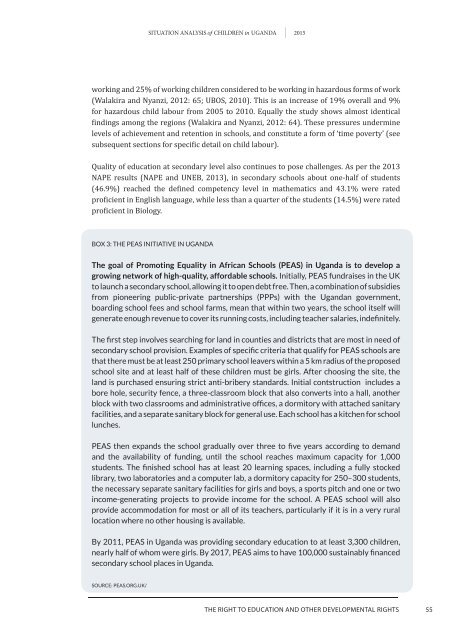Situation analySiS
1TNu802
1TNu802
You also want an ePaper? Increase the reach of your titles
YUMPU automatically turns print PDFs into web optimized ePapers that Google loves.
<strong>Situation</strong> <strong>analySiS</strong> of Children in uganda 2015working and 25% of working children considered to be working in hazardous forms of work(Walakira and Nyanzi, 2012: 65; UBOS, 2010). This is an increase of 19% overall and 9%for hazardous child labour from 2005 to 2010. Equally the study shows almost identicalfindings among the regions (Walakira and Nyanzi, 2012: 64). These pressures underminelevels of achievement and retention in schools, and constitute a form of ‘time poverty’ (seesubsequent sections for specific detail on child labour).Quality of education at secondary level also continues to pose challenges. As per the 2013NAPE results (NAPE and UNEB, 2013), in secondary schools about one-half of students(46.9%) reached the defined competency level in mathematics and 43.1% were ratedproficient in English language, while less than a quarter of the students (14.5%) were ratedproficient in Biology.boX 3: the peAs initiAtive in uGAndAThe goal of Promoting Equality in African Schools (PEAS) in Uganda is to develop agrowing network of high-quality, affordable schools. initially, peAs fundraises in the uKto launch a secondary school, allowing it to open debt free. then, a combination of subsidiesfrom pioneering public-private partnerships (ppps) with the ugandan government,boarding school fees and school farms, mean that within two years, the school itself willgenerate enough revenue to cover its running costs, including teacher salaries, indefinitely.The first step involves searching for land in counties and districts that are most in need ofsecondary school provision. Examples of specific criteria that qualify for PEAS schools arethat there must be at least 250 primary school leavers within a 5 km radius of the proposedschool site and at least half of these children must be girls. After choosing the site, theland is purchased ensuring strict anti-bribery standards. initial contstruction includes abore hole, security fence, a three-classroom block that also converts into a hall, anotherblock with two classrooms and administrative offices, a dormitory with attached sanitaryfacilities, and a separate sanitary block for general use. each school has a kitchen for schoollunches.PEAS then expands the school gradually over three to five years according to demandand the availability of funding, until the school reaches maximum capacity for 1,000students. The finished school has at least 20 learning spaces, including a fully stockedlibrary, two laboratories and a computer lab, a dormitory capacity for 250–300 students,the necessary separate sanitary facilities for girls and boys, a sports pitch and one or twoincome-generating projects to provide income for the school. A peAs school will alsoprovide accommodation for most or all of its teachers, particularly if it is in a very rurallocation where no other housing is available.by 2011, peAs in uganda was providing secondary education to at least 3,300 children,nearly half of whom were girls. By 2017, PEAS aims to have 100,000 sustainably financedsecondary school places in uganda.source: peAs.orG.uK/thE rIGht to EDUCatIoN aND othEr DEvELoPMENtaL rIGhtS55




